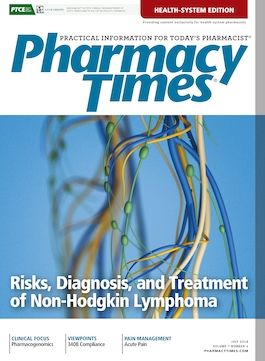Publication
Article
Pharmacy Practice in Focus: Health Systems
Pharmacogenomics, Enzyme Competition, and the Evolution of Precision Prescribing
Author(s):
It is understood that a person’s genetics determines traits such as eye, hair, and skin color and even the predisposition to contracting certain diseases.
It is understood that a person’s genetics determines traits such as eye, hair, and skin color and even the predisposition to contracting certain diseases.
However, it is not always recognized that genes control the ability to metabolize many commonly used drugs, including illicit and recreational ones such as marijuana; OTC and prescription medications; and several herbal remedies.
Precision prescribing is an evolving method of chronic disease management and prevention that considers a person’s individuality when choosing drug therapy. Under this model, individual genetic variance, lifestyle, and metabolic and elimination potential are all considered when initiating and adjusting treatment. Unlike population-based methods, precision prescribing may allow us to better predict individual outcomes and mitigate adverse drug events. In his 2015 State of the Union address, President Barack Obama launched the nation’s Precision Medicine Initiative, aimed at finding cures or at least effective and predictable treatments for diseases such as cancer, cystic fibrosis, and diabetes. Although the term precision prescribing seems novel, the model has been in practice for many years. Basing drug choice and dose on a patient’s renal or hepatic function, age, ability to swallow, comorbidities, and concomitant therapies has been part of the prescribing framework for decades.
Although some hematologic, immunologic, and oncologic circumstances do use genomic testing, the contribution of a person’s genetic profile has not routinely been part of the decision process. However, this is a new era of medicine in which information gleaned from the mapping of the human genome can help reliably deliver the correct drug at the correct dose for many of the diseases that we have struggled to manage for decades. As pharmacogenomic (PGx) testing becomes more common and practitioners more educated and comfortable with using the data gleaned, the idea of precision prescribing will continue to advance and ultimately become the norm. Genetic information extracted from a noninvasive cheek swab or a small vial of saliva can give pharmacists and prescribers valuable examples of many of a patient’s individual drug-metabolizing enzymes, receptor characteristics, and transporters. Unlike routine lab values that change over time or circumstance, such as glycated hemoglobin, cholesterol, and international normalized ratio, a patient’s PGx profile needs to be taken only once, as these genes will not change over a lifetime.
The following is a real case from a health plan member that illustrates the benefits of gene-based and PGx-informed dosing.
RF is a 60-year-old white woman who is being treated for chronic anxiety and resistant depression. Besides her poorly managed mental health issues, her chief complaints are excessive dryness of the eyes, mouth, and skin; a reduced ability to concentrate; and sedation.
RF’s medication profile includes alprazolam (Xanax), aripiprazole (Abilify), bupropion (Wellbutrin XL), dicyclomine (Bentyl), duloxetine (Cymbalta), lorazepam (Ativan), 18 mg of methylphenidate (Concerta), and 10 mg of montelukast (Singulair).
Along with the patient history and medication profile, a PGx evaluation was completed, which provided needed insight into RF’s medication experience.
The results were:
- CYP1A2: *1*1 Extensive (normal) metabolizer
- CYP2C9: *1*1 Extensive (normal) metabolizer
- CYP3A4: *1*1 Extensive (normal) metabolizer
- CYP2B6: *1*6 Intermediate metabolizer
- CYP2C19: *1*2 Intermediate metabolizer
- CYP2D6: *1/*1x4 Ultrarapid metabolizer
Findings
RF has been taking aripiprazole, bupropion, and duloxetine at the same time every morning. But PGx results show that she is an ultrarapid metabolizer of enzyme CYP2D6. With RF’s phenotype, none of these 3 medications is recommended, as she would have difficulty achieving effective serum drug levels because of rapid deactivation and elimination of those drugs taken at normal doses. She presents with the expected adverse effects, yet she has received minimal benefits.
RF has been taking alprazolam, as needed in the morning, for anxiety and lorazepam at bedtime for anxiety and/or to help with sleep issues. This combination is questionable, as there is no clinical advantage or indication for concurrent use of 2 benzodiazepines, and alprazolam competes for elimination metabolism via CYP3A4 with the aripiprazole. Lorazepam is a non-CYP benzodiazepine, with elimination via hepatic glucuronidation.
Typical dosing of dicyclomine is 10 to 20 mg up to 4 times a day, half an hour before meals and at bedtime, on an empty stomach, so that it can begin working prior to food consumption, which often initiates cramping and pain. RF said that she was administering only once daily after eating. She also said that it has not helped her “nervous stomach.”
Methylphenidate was added to counteract the sedative effects of the other medications.
Recommendations
- Because, in this case, methylphenidate was added to enhance wakefulness, discontinue it once the sedative effects of RF’s original therapy dissipate.
- Continue 10 mg of montelukast once daily at bedtime during allergy season.
- Discontinue alprazolam. Use 0.5 mg of lorazepam once daily at bedtime and an additional tablet up to twice daily if needed for anxiety or nerves.
- Discontinue dicyclomine, which is associated with several adverse effects, many of which RF is experiencing, including blurred vision, confusion, constipation, dry eyes and mouth, and urinary retention.
- Taper and discontinue aripiprazole, bupropion, and duloxetine while slowly initiating sertraline (Zoloft). Sertraline is not affected by RF’s 2D6 genetic variant, so she should respond within population norms.
Outcome
RF started a careful and slow transition to the new regimen. After 12 weeks on her new treatment, she is happier and more positive and social and has significantly fewer acute anxiety and panic episodes.
Robert L. Alesiani, PharmD, BCGP, is the chief pharmacotherapy officer at Tabula Rasa HealthCare in Moorestown, New Jersey.







